Safeguarding Vulnerable Individuals: Health and Social Care Report
VerifiedAdded on 2023/06/11
|17
|5540
|227
Report
AI Summary
This report provides a comprehensive overview of safeguarding in health and social care, emphasizing the importance of protecting vulnerable individuals from harm, abuse, and neglect. It highlights the advantages and disadvantages of safeguarding practices, including improved communication and reporting, as well as challenges such as inconsistent practices and lack of clarity in roles. The report details the role of safeguarding in ensuring human rights and protecting individuals from various forms of abuse, and examines current legislation such as the Health and Social Care Act 2012 and the Care Act 2014, along with other relevant acts concerning children and adults. It further explains the relationship between legislation, policies, and procedures, and identifies specific safeguarding policies in health and social care, such as anti-bullying and whistleblowing policies. The report also discusses factors contributing to individual vulnerability and the steps health and social care practitioners can take to safeguard themselves, concluding with actions to report abuse and the importance of raising awareness within health and social care settings. Desklib offers a wealth of similar resources for students.
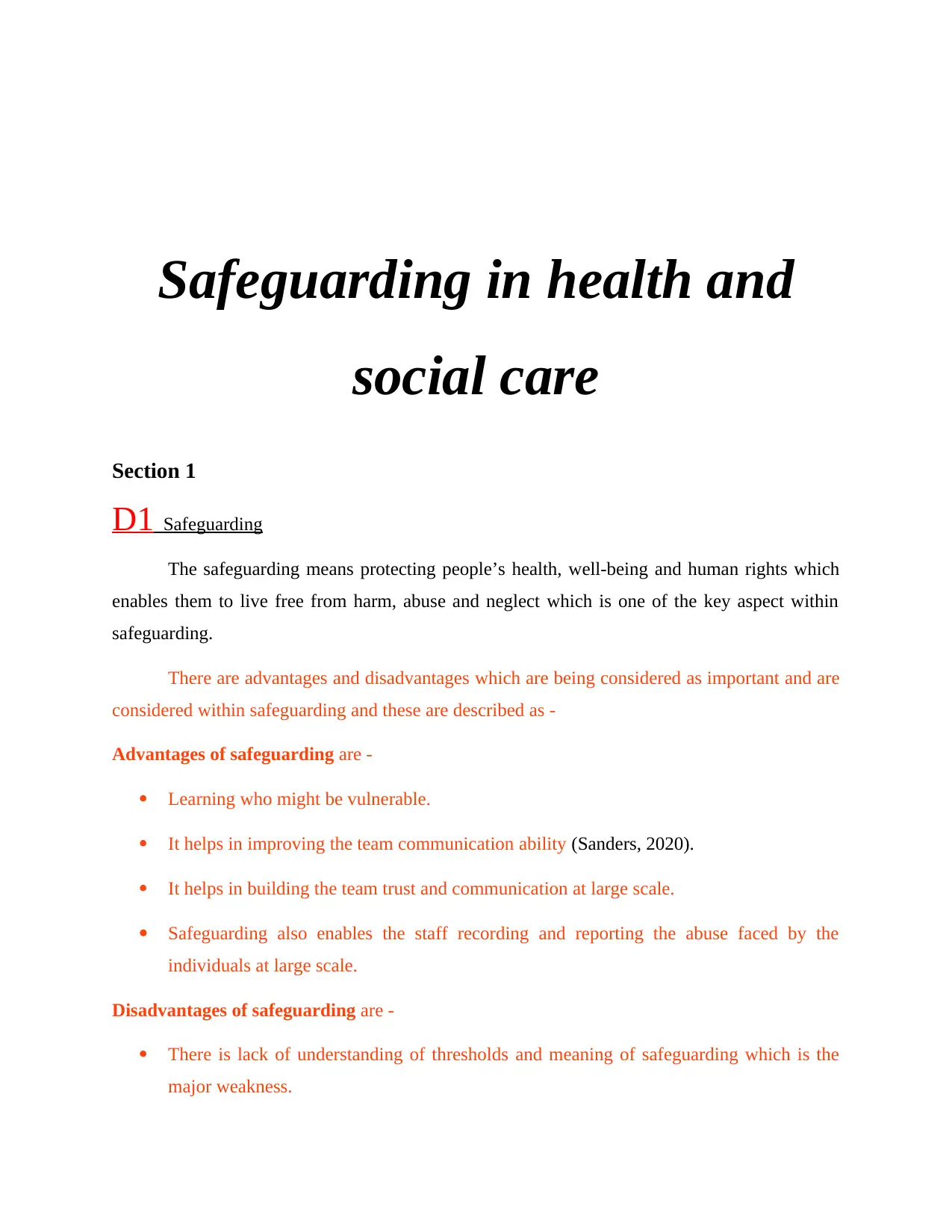
Safeguarding in health and
social care
Section 1
D1 Safeguarding
The safeguarding means protecting people’s health, well-being and human rights which
enables them to live free from harm, abuse and neglect which is one of the key aspect within
safeguarding.
There are advantages and disadvantages which are being considered as important and are
considered within safeguarding and these are described as -
Advantages of safeguarding are -
Learning who might be vulnerable.
It helps in improving the team communication ability (Sanders, 2020).
It helps in building the team trust and communication at large scale.
Safeguarding also enables the staff recording and reporting the abuse faced by the
individuals at large scale.
Disadvantages of safeguarding are -
There is lack of understanding of thresholds and meaning of safeguarding which is the
major weakness.
social care
Section 1
D1 Safeguarding
The safeguarding means protecting people’s health, well-being and human rights which
enables them to live free from harm, abuse and neglect which is one of the key aspect within
safeguarding.
There are advantages and disadvantages which are being considered as important and are
considered within safeguarding and these are described as -
Advantages of safeguarding are -
Learning who might be vulnerable.
It helps in improving the team communication ability (Sanders, 2020).
It helps in building the team trust and communication at large scale.
Safeguarding also enables the staff recording and reporting the abuse faced by the
individuals at large scale.
Disadvantages of safeguarding are -
There is lack of understanding of thresholds and meaning of safeguarding which is the
major weakness.
Paraphrase This Document
Need a fresh take? Get an instant paraphrase of this document with our AI Paraphraser
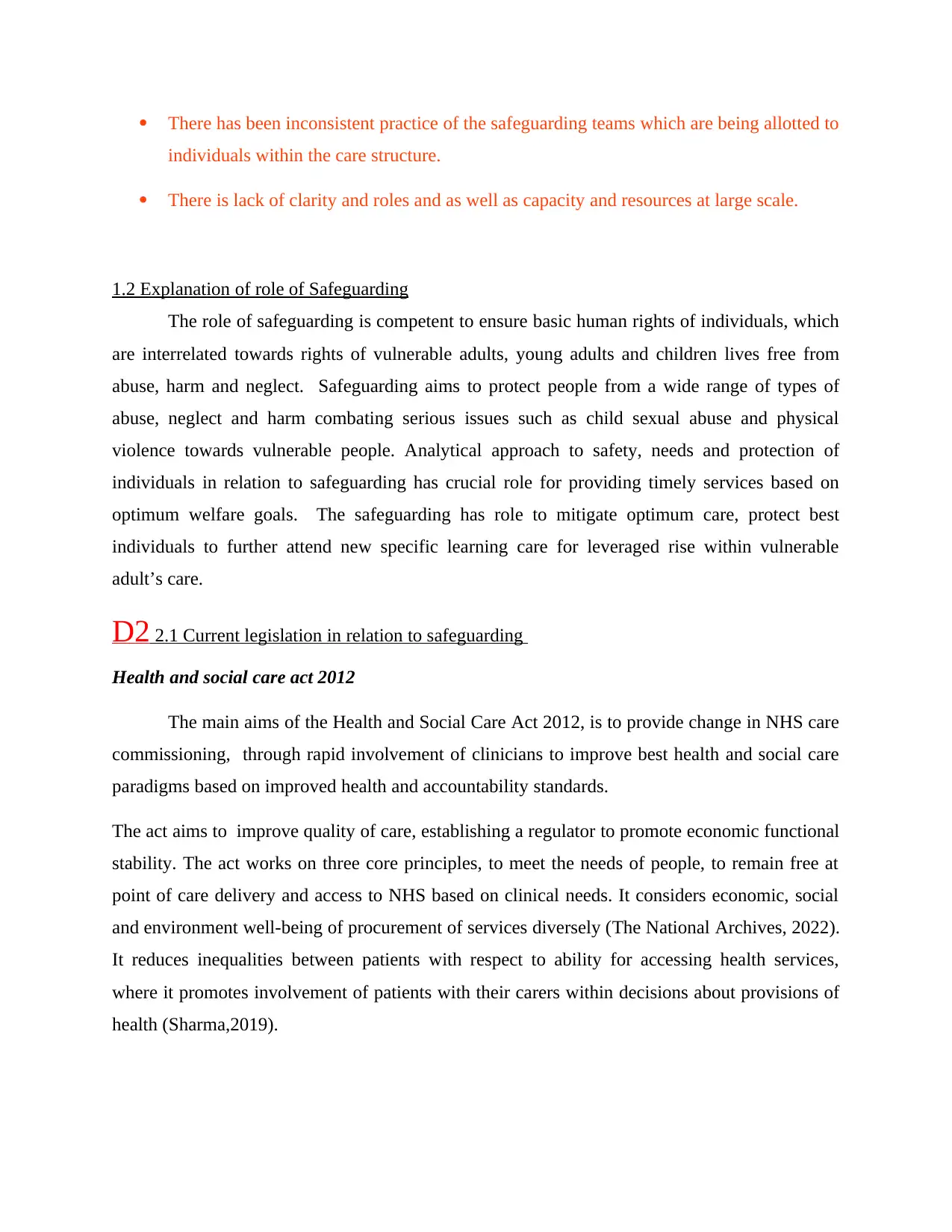
There has been inconsistent practice of the safeguarding teams which are being allotted to
individuals within the care structure.
There is lack of clarity and roles and as well as capacity and resources at large scale.
1.2 Explanation of role of Safeguarding
The role of safeguarding is competent to ensure basic human rights of individuals, which
are interrelated towards rights of vulnerable adults, young adults and children lives free from
abuse, harm and neglect. Safeguarding aims to protect people from a wide range of types of
abuse, neglect and harm combating serious issues such as child sexual abuse and physical
violence towards vulnerable people. Analytical approach to safety, needs and protection of
individuals in relation to safeguarding has crucial role for providing timely services based on
optimum welfare goals. The safeguarding has role to mitigate optimum care, protect best
individuals to further attend new specific learning care for leveraged rise within vulnerable
adult’s care.
D2 2.1 Current legislation in relation to safeguarding
Health and social care act 2012
The main aims of the Health and Social Care Act 2012, is to provide change in NHS care
commissioning, through rapid involvement of clinicians to improve best health and social care
paradigms based on improved health and accountability standards.
The act aims to improve quality of care, establishing a regulator to promote economic functional
stability. The act works on three core principles, to meet the needs of people, to remain free at
point of care delivery and access to NHS based on clinical needs. It considers economic, social
and environment well-being of procurement of services diversely (The National Archives, 2022).
It reduces inequalities between patients with respect to ability for accessing health services,
where it promotes involvement of patients with their carers within decisions about provisions of
health (Sharma,2019).
individuals within the care structure.
There is lack of clarity and roles and as well as capacity and resources at large scale.
1.2 Explanation of role of Safeguarding
The role of safeguarding is competent to ensure basic human rights of individuals, which
are interrelated towards rights of vulnerable adults, young adults and children lives free from
abuse, harm and neglect. Safeguarding aims to protect people from a wide range of types of
abuse, neglect and harm combating serious issues such as child sexual abuse and physical
violence towards vulnerable people. Analytical approach to safety, needs and protection of
individuals in relation to safeguarding has crucial role for providing timely services based on
optimum welfare goals. The safeguarding has role to mitigate optimum care, protect best
individuals to further attend new specific learning care for leveraged rise within vulnerable
adult’s care.
D2 2.1 Current legislation in relation to safeguarding
Health and social care act 2012
The main aims of the Health and Social Care Act 2012, is to provide change in NHS care
commissioning, through rapid involvement of clinicians to improve best health and social care
paradigms based on improved health and accountability standards.
The act aims to improve quality of care, establishing a regulator to promote economic functional
stability. The act works on three core principles, to meet the needs of people, to remain free at
point of care delivery and access to NHS based on clinical needs. It considers economic, social
and environment well-being of procurement of services diversely (The National Archives, 2022).
It reduces inequalities between patients with respect to ability for accessing health services,
where it promotes involvement of patients with their carers within decisions about provisions of
health (Sharma,2019).
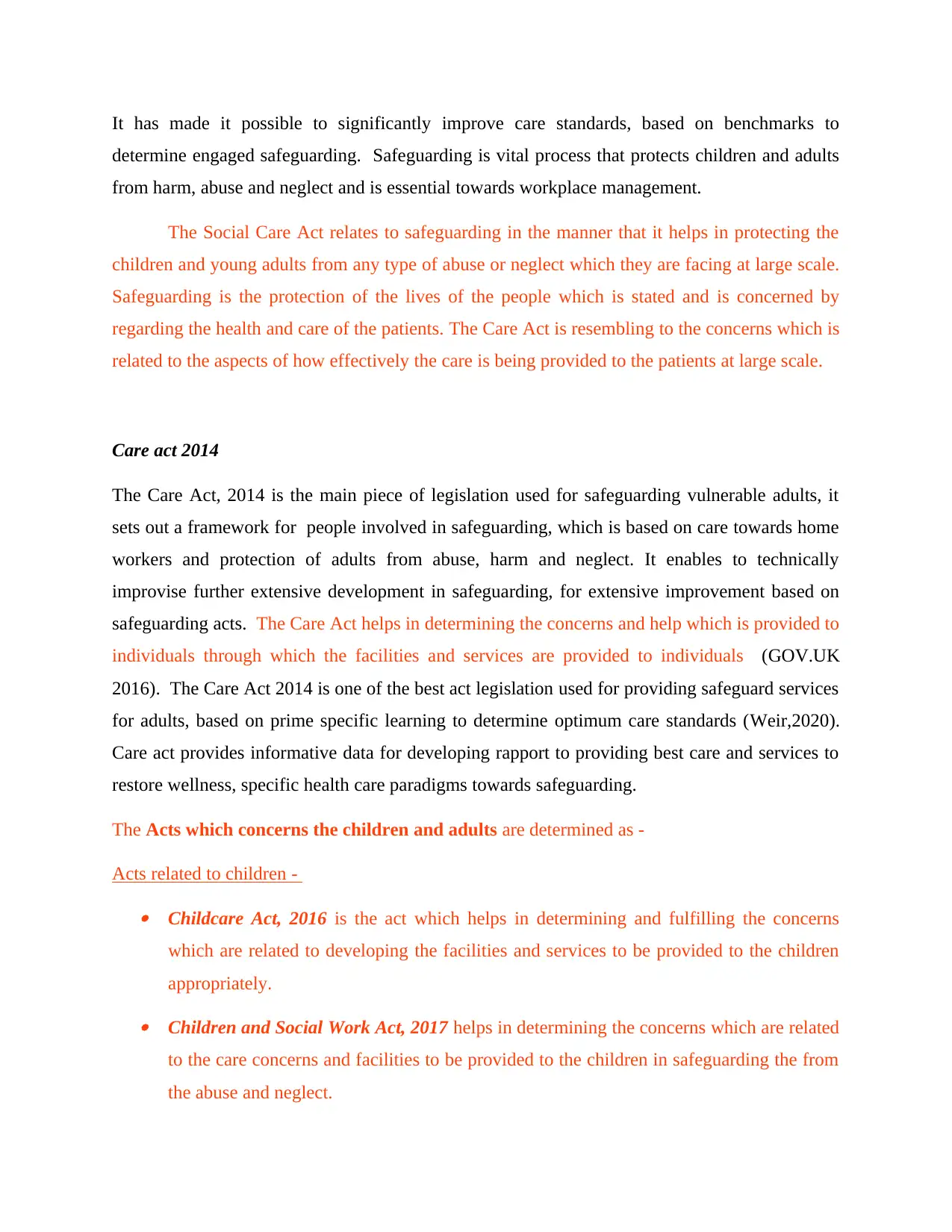
It has made it possible to significantly improve care standards, based on benchmarks to
determine engaged safeguarding. Safeguarding is vital process that protects children and adults
from harm, abuse and neglect and is essential towards workplace management.
The Social Care Act relates to safeguarding in the manner that it helps in protecting the
children and young adults from any type of abuse or neglect which they are facing at large scale.
Safeguarding is the protection of the lives of the people which is stated and is concerned by
regarding the health and care of the patients. The Care Act is resembling to the concerns which is
related to the aspects of how effectively the care is being provided to the patients at large scale.
Care act 2014
The Care Act, 2014 is the main piece of legislation used for safeguarding vulnerable adults, it
sets out a framework for people involved in safeguarding, which is based on care towards home
workers and protection of adults from abuse, harm and neglect. It enables to technically
improvise further extensive development in safeguarding, for extensive improvement based on
safeguarding acts. The Care Act helps in determining the concerns and help which is provided to
individuals through which the facilities and services are provided to individuals (GOV.UK
2016). The Care Act 2014 is one of the best act legislation used for providing safeguard services
for adults, based on prime specific learning to determine optimum care standards (Weir,2020).
Care act provides informative data for developing rapport to providing best care and services to
restore wellness, specific health care paradigms towards safeguarding.
The Acts which concerns the children and adults are determined as -
Acts related to children - Childcare Act, 2016 is the act which helps in determining and fulfilling the concerns
which are related to developing the facilities and services to be provided to the children
appropriately. Children and Social Work Act, 2017 helps in determining the concerns which are related
to the care concerns and facilities to be provided to the children in safeguarding the from
the abuse and neglect.
determine engaged safeguarding. Safeguarding is vital process that protects children and adults
from harm, abuse and neglect and is essential towards workplace management.
The Social Care Act relates to safeguarding in the manner that it helps in protecting the
children and young adults from any type of abuse or neglect which they are facing at large scale.
Safeguarding is the protection of the lives of the people which is stated and is concerned by
regarding the health and care of the patients. The Care Act is resembling to the concerns which is
related to the aspects of how effectively the care is being provided to the patients at large scale.
Care act 2014
The Care Act, 2014 is the main piece of legislation used for safeguarding vulnerable adults, it
sets out a framework for people involved in safeguarding, which is based on care towards home
workers and protection of adults from abuse, harm and neglect. It enables to technically
improvise further extensive development in safeguarding, for extensive improvement based on
safeguarding acts. The Care Act helps in determining the concerns and help which is provided to
individuals through which the facilities and services are provided to individuals (GOV.UK
2016). The Care Act 2014 is one of the best act legislation used for providing safeguard services
for adults, based on prime specific learning to determine optimum care standards (Weir,2020).
Care act provides informative data for developing rapport to providing best care and services to
restore wellness, specific health care paradigms towards safeguarding.
The Acts which concerns the children and adults are determined as -
Acts related to children - Childcare Act, 2016 is the act which helps in determining and fulfilling the concerns
which are related to developing the facilities and services to be provided to the children
appropriately. Children and Social Work Act, 2017 helps in determining the concerns which are related
to the care concerns and facilities to be provided to the children in safeguarding the from
the abuse and neglect.
⊘ This is a preview!⊘
Do you want full access?
Subscribe today to unlock all pages.

Trusted by 1+ million students worldwide
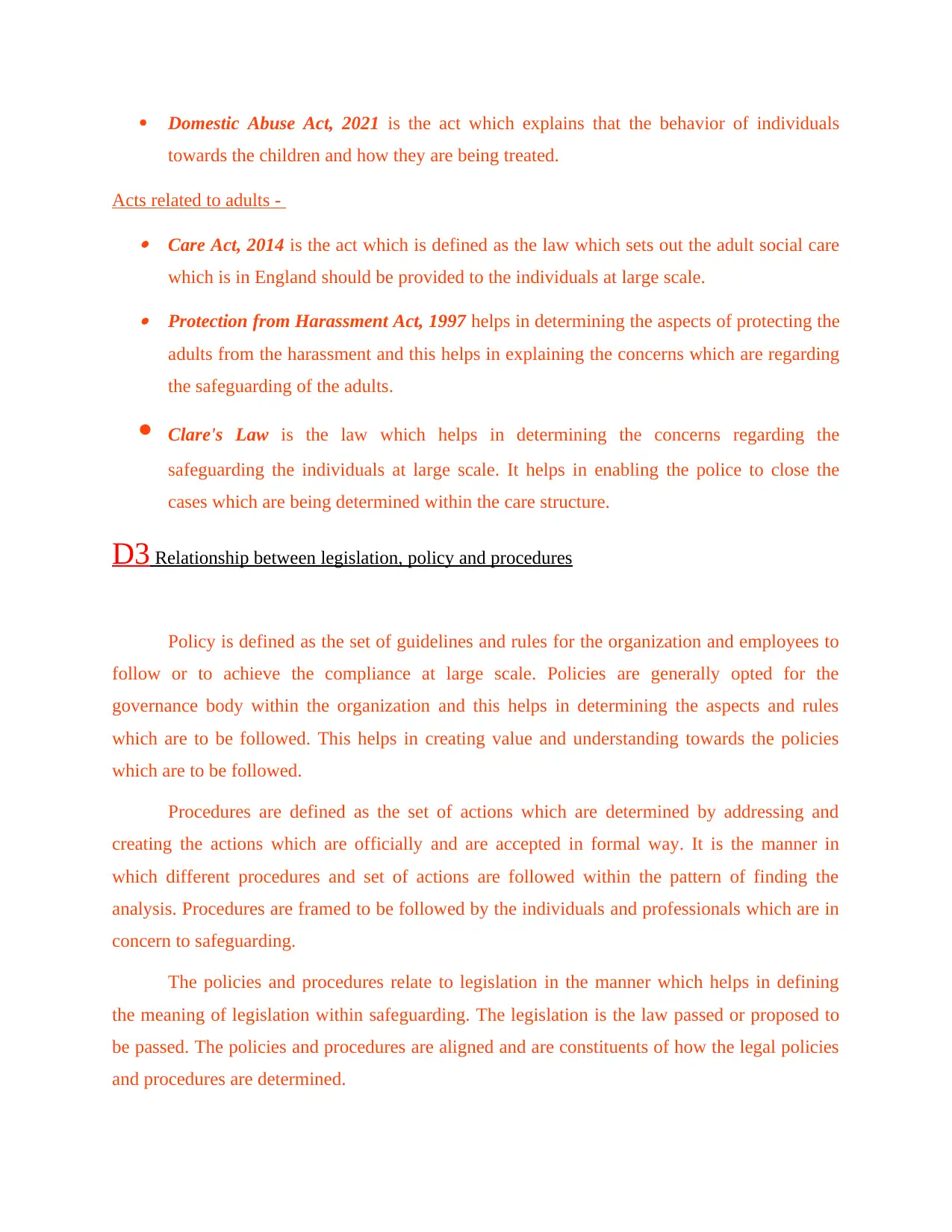
Domestic Abuse Act, 2021 is the act which explains that the behavior of individuals
towards the children and how they are being treated.
Acts related to adults - Care Act, 2014 is the act which is defined as the law which sets out the adult social care
which is in England should be provided to the individuals at large scale. Protection from Harassment Act, 1997 helps in determining the aspects of protecting the
adults from the harassment and this helps in explaining the concerns which are regarding
the safeguarding of the adults.
Clare's Law is the law which helps in determining the concerns regarding the
safeguarding the individuals at large scale. It helps in enabling the police to close the
cases which are being determined within the care structure.
D3 Relationship between legislation, policy and procedures
Policy is defined as the set of guidelines and rules for the organization and employees to
follow or to achieve the compliance at large scale. Policies are generally opted for the
governance body within the organization and this helps in determining the aspects and rules
which are to be followed. This helps in creating value and understanding towards the policies
which are to be followed.
Procedures are defined as the set of actions which are determined by addressing and
creating the actions which are officially and are accepted in formal way. It is the manner in
which different procedures and set of actions are followed within the pattern of finding the
analysis. Procedures are framed to be followed by the individuals and professionals which are in
concern to safeguarding.
The policies and procedures relate to legislation in the manner which helps in defining
the meaning of legislation within safeguarding. The legislation is the law passed or proposed to
be passed. The policies and procedures are aligned and are constituents of how the legal policies
and procedures are determined.
towards the children and how they are being treated.
Acts related to adults - Care Act, 2014 is the act which is defined as the law which sets out the adult social care
which is in England should be provided to the individuals at large scale. Protection from Harassment Act, 1997 helps in determining the aspects of protecting the
adults from the harassment and this helps in explaining the concerns which are regarding
the safeguarding of the adults.
Clare's Law is the law which helps in determining the concerns regarding the
safeguarding the individuals at large scale. It helps in enabling the police to close the
cases which are being determined within the care structure.
D3 Relationship between legislation, policy and procedures
Policy is defined as the set of guidelines and rules for the organization and employees to
follow or to achieve the compliance at large scale. Policies are generally opted for the
governance body within the organization and this helps in determining the aspects and rules
which are to be followed. This helps in creating value and understanding towards the policies
which are to be followed.
Procedures are defined as the set of actions which are determined by addressing and
creating the actions which are officially and are accepted in formal way. It is the manner in
which different procedures and set of actions are followed within the pattern of finding the
analysis. Procedures are framed to be followed by the individuals and professionals which are in
concern to safeguarding.
The policies and procedures relate to legislation in the manner which helps in defining
the meaning of legislation within safeguarding. The legislation is the law passed or proposed to
be passed. The policies and procedures are aligned and are constituents of how the legal policies
and procedures are determined.
Paraphrase This Document
Need a fresh take? Get an instant paraphrase of this document with our AI Paraphraser
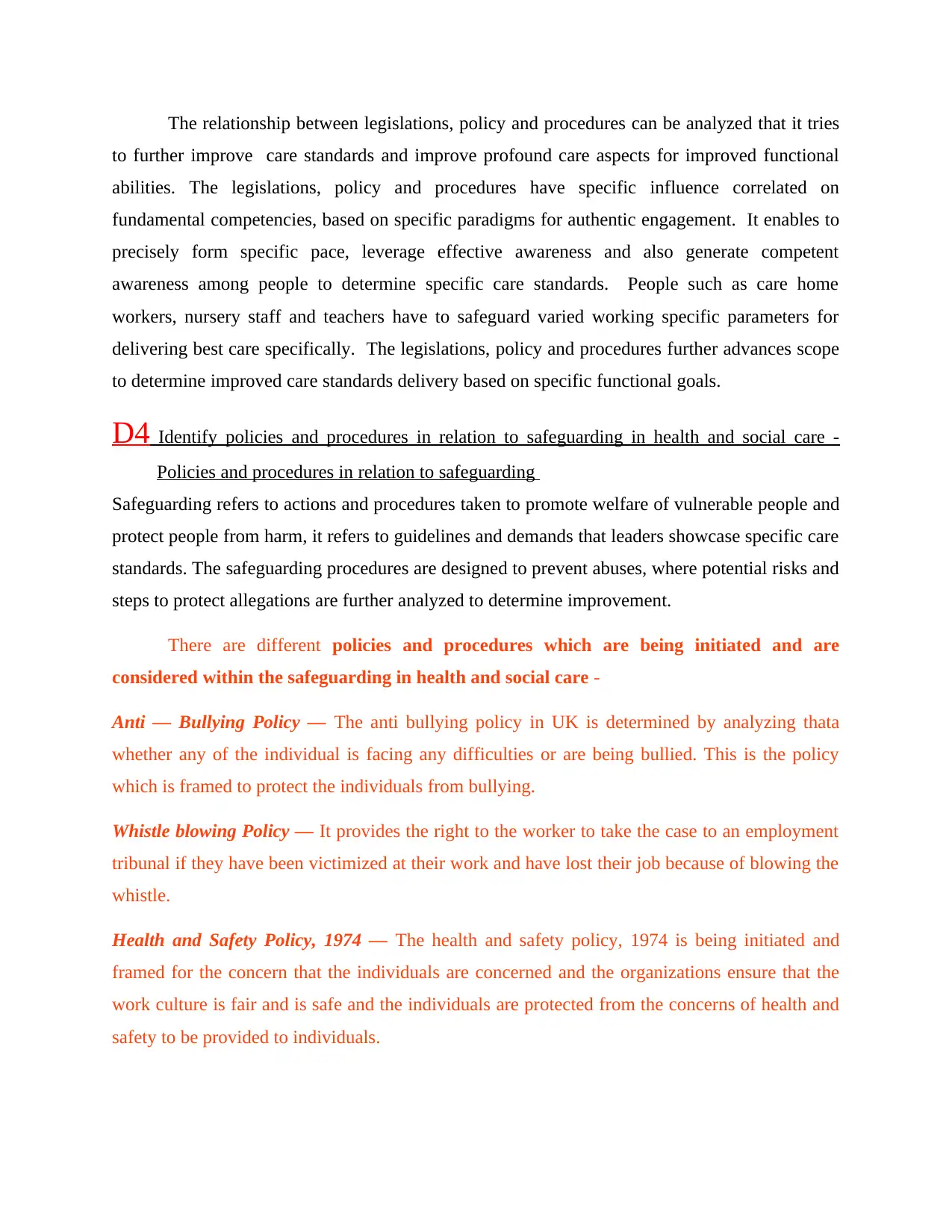
The relationship between legislations, policy and procedures can be analyzed that it tries
to further improve care standards and improve profound care aspects for improved functional
abilities. The legislations, policy and procedures have specific influence correlated on
fundamental competencies, based on specific paradigms for authentic engagement. It enables to
precisely form specific pace, leverage effective awareness and also generate competent
awareness among people to determine specific care standards. People such as care home
workers, nursery staff and teachers have to safeguard varied working specific parameters for
delivering best care specifically. The legislations, policy and procedures further advances scope
to determine improved care standards delivery based on specific functional goals.
D4 Identify policies and procedures in relation to safeguarding in health and social care -
Policies and procedures in relation to safeguarding
Safeguarding refers to actions and procedures taken to promote welfare of vulnerable people and
protect people from harm, it refers to guidelines and demands that leaders showcase specific care
standards. The safeguarding procedures are designed to prevent abuses, where potential risks and
steps to protect allegations are further analyzed to determine improvement.
There are different policies and procedures which are being initiated and are
considered within the safeguarding in health and social care -
Anti — Bullying Policy — The anti bullying policy in UK is determined by analyzing thata
whether any of the individual is facing any difficulties or are being bullied. This is the policy
which is framed to protect the individuals from bullying.
Whistle blowing Policy — It provides the right to the worker to take the case to an employment
tribunal if they have been victimized at their work and have lost their job because of blowing the
whistle.
Health and Safety Policy, 1974 — The health and safety policy, 1974 is being initiated and
framed for the concern that the individuals are concerned and the organizations ensure that the
work culture is fair and is safe and the individuals are protected from the concerns of health and
safety to be provided to individuals.
to further improve care standards and improve profound care aspects for improved functional
abilities. The legislations, policy and procedures have specific influence correlated on
fundamental competencies, based on specific paradigms for authentic engagement. It enables to
precisely form specific pace, leverage effective awareness and also generate competent
awareness among people to determine specific care standards. People such as care home
workers, nursery staff and teachers have to safeguard varied working specific parameters for
delivering best care specifically. The legislations, policy and procedures further advances scope
to determine improved care standards delivery based on specific functional goals.
D4 Identify policies and procedures in relation to safeguarding in health and social care -
Policies and procedures in relation to safeguarding
Safeguarding refers to actions and procedures taken to promote welfare of vulnerable people and
protect people from harm, it refers to guidelines and demands that leaders showcase specific care
standards. The safeguarding procedures are designed to prevent abuses, where potential risks and
steps to protect allegations are further analyzed to determine improvement.
There are different policies and procedures which are being initiated and are
considered within the safeguarding in health and social care -
Anti — Bullying Policy — The anti bullying policy in UK is determined by analyzing thata
whether any of the individual is facing any difficulties or are being bullied. This is the policy
which is framed to protect the individuals from bullying.
Whistle blowing Policy — It provides the right to the worker to take the case to an employment
tribunal if they have been victimized at their work and have lost their job because of blowing the
whistle.
Health and Safety Policy, 1974 — The health and safety policy, 1974 is being initiated and
framed for the concern that the individuals are concerned and the organizations ensure that the
work culture is fair and is safe and the individuals are protected from the concerns of health and
safety to be provided to individuals.
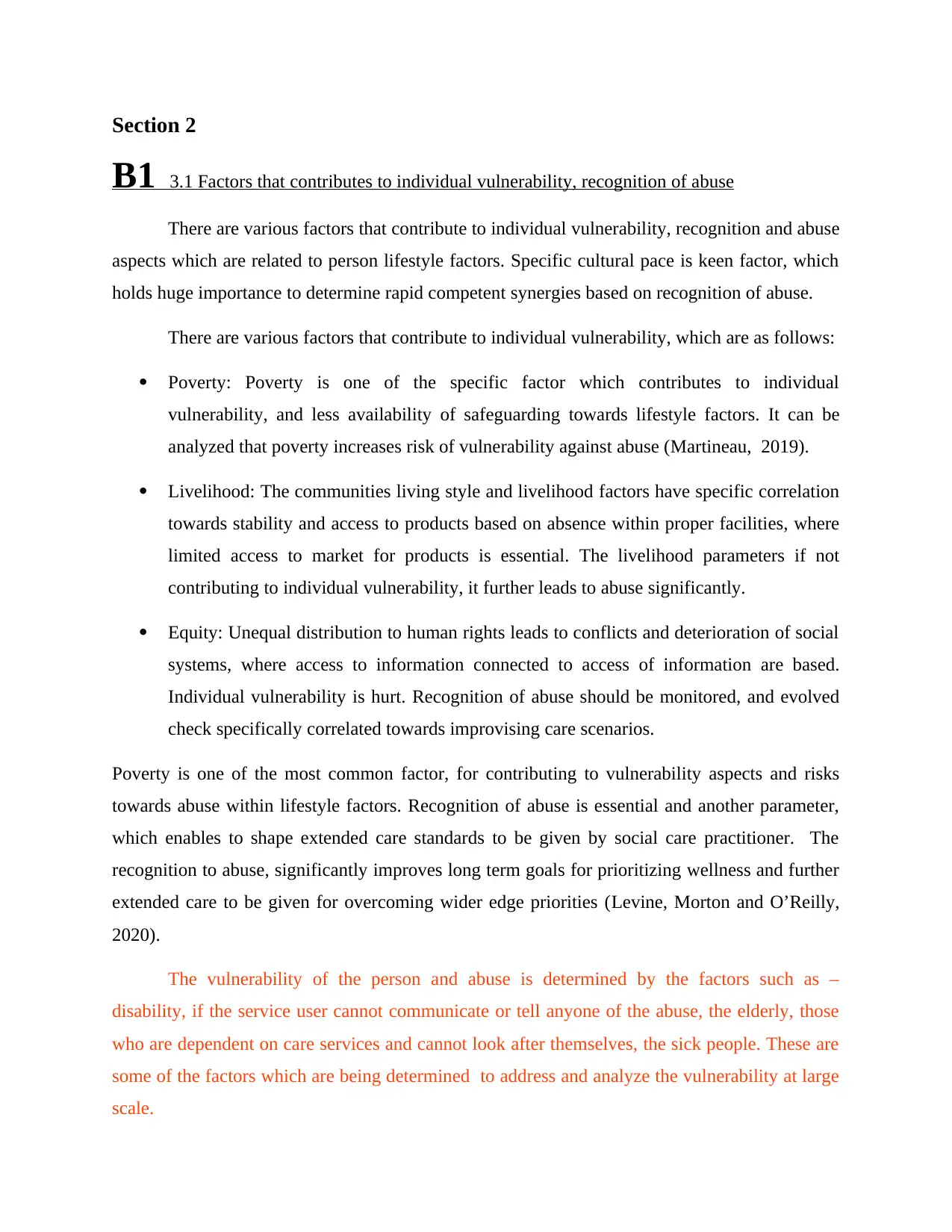
Section 2
B1 3.1 Factors that contributes to individual vulnerability, recognition of abuse
There are various factors that contribute to individual vulnerability, recognition and abuse
aspects which are related to person lifestyle factors. Specific cultural pace is keen factor, which
holds huge importance to determine rapid competent synergies based on recognition of abuse.
There are various factors that contribute to individual vulnerability, which are as follows:
Poverty: Poverty is one of the specific factor which contributes to individual
vulnerability, and less availability of safeguarding towards lifestyle factors. It can be
analyzed that poverty increases risk of vulnerability against abuse (Martineau, 2019).
Livelihood: The communities living style and livelihood factors have specific correlation
towards stability and access to products based on absence within proper facilities, where
limited access to market for products is essential. The livelihood parameters if not
contributing to individual vulnerability, it further leads to abuse significantly.
Equity: Unequal distribution to human rights leads to conflicts and deterioration of social
systems, where access to information connected to access of information are based.
Individual vulnerability is hurt. Recognition of abuse should be monitored, and evolved
check specifically correlated towards improvising care scenarios.
Poverty is one of the most common factor, for contributing to vulnerability aspects and risks
towards abuse within lifestyle factors. Recognition of abuse is essential and another parameter,
which enables to shape extended care standards to be given by social care practitioner. The
recognition to abuse, significantly improves long term goals for prioritizing wellness and further
extended care to be given for overcoming wider edge priorities (Levine, Morton and O’Reilly,
2020).
The vulnerability of the person and abuse is determined by the factors such as –
disability, if the service user cannot communicate or tell anyone of the abuse, the elderly, those
who are dependent on care services and cannot look after themselves, the sick people. These are
some of the factors which are being determined to address and analyze the vulnerability at large
scale.
B1 3.1 Factors that contributes to individual vulnerability, recognition of abuse
There are various factors that contribute to individual vulnerability, recognition and abuse
aspects which are related to person lifestyle factors. Specific cultural pace is keen factor, which
holds huge importance to determine rapid competent synergies based on recognition of abuse.
There are various factors that contribute to individual vulnerability, which are as follows:
Poverty: Poverty is one of the specific factor which contributes to individual
vulnerability, and less availability of safeguarding towards lifestyle factors. It can be
analyzed that poverty increases risk of vulnerability against abuse (Martineau, 2019).
Livelihood: The communities living style and livelihood factors have specific correlation
towards stability and access to products based on absence within proper facilities, where
limited access to market for products is essential. The livelihood parameters if not
contributing to individual vulnerability, it further leads to abuse significantly.
Equity: Unequal distribution to human rights leads to conflicts and deterioration of social
systems, where access to information connected to access of information are based.
Individual vulnerability is hurt. Recognition of abuse should be monitored, and evolved
check specifically correlated towards improvising care scenarios.
Poverty is one of the most common factor, for contributing to vulnerability aspects and risks
towards abuse within lifestyle factors. Recognition of abuse is essential and another parameter,
which enables to shape extended care standards to be given by social care practitioner. The
recognition to abuse, significantly improves long term goals for prioritizing wellness and further
extended care to be given for overcoming wider edge priorities (Levine, Morton and O’Reilly,
2020).
The vulnerability of the person and abuse is determined by the factors such as –
disability, if the service user cannot communicate or tell anyone of the abuse, the elderly, those
who are dependent on care services and cannot look after themselves, the sick people. These are
some of the factors which are being determined to address and analyze the vulnerability at large
scale.
⊘ This is a preview!⊘
Do you want full access?
Subscribe today to unlock all pages.

Trusted by 1+ million students worldwide
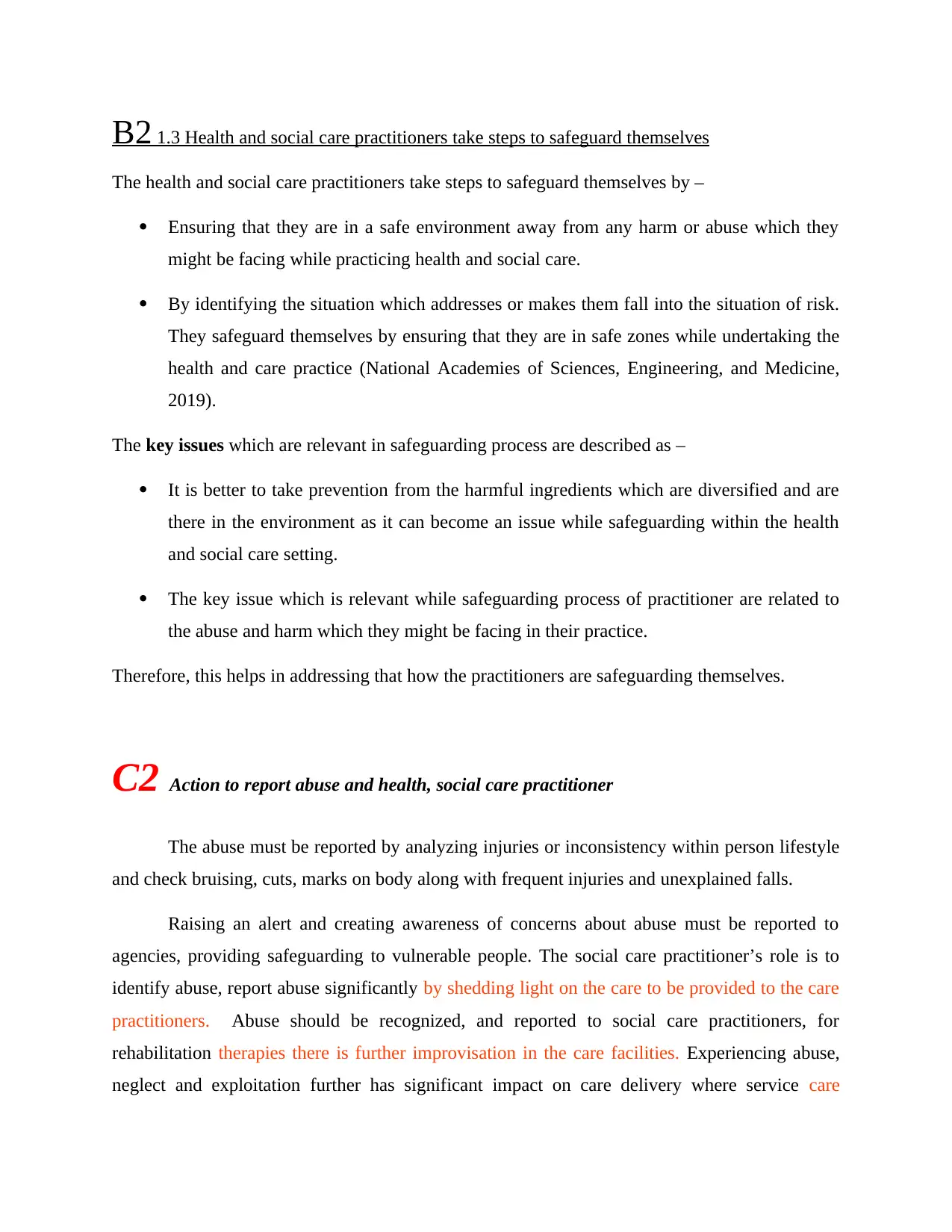
B2 1.3 Health and social care practitioners take steps to safeguard themselves
The health and social care practitioners take steps to safeguard themselves by –
Ensuring that they are in a safe environment away from any harm or abuse which they
might be facing while practicing health and social care.
By identifying the situation which addresses or makes them fall into the situation of risk.
They safeguard themselves by ensuring that they are in safe zones while undertaking the
health and care practice (National Academies of Sciences, Engineering, and Medicine,
2019).
The key issues which are relevant in safeguarding process are described as –
It is better to take prevention from the harmful ingredients which are diversified and are
there in the environment as it can become an issue while safeguarding within the health
and social care setting.
The key issue which is relevant while safeguarding process of practitioner are related to
the abuse and harm which they might be facing in their practice.
Therefore, this helps in addressing that how the practitioners are safeguarding themselves.
C2 Action to report abuse and health, social care practitioner
The abuse must be reported by analyzing injuries or inconsistency within person lifestyle
and check bruising, cuts, marks on body along with frequent injuries and unexplained falls.
Raising an alert and creating awareness of concerns about abuse must be reported to
agencies, providing safeguarding to vulnerable people. The social care practitioner’s role is to
identify abuse, report abuse significantly by shedding light on the care to be provided to the care
practitioners. Abuse should be recognized, and reported to social care practitioners, for
rehabilitation therapies there is further improvisation in the care facilities. Experiencing abuse,
neglect and exploitation further has significant impact on care delivery where service care
The health and social care practitioners take steps to safeguard themselves by –
Ensuring that they are in a safe environment away from any harm or abuse which they
might be facing while practicing health and social care.
By identifying the situation which addresses or makes them fall into the situation of risk.
They safeguard themselves by ensuring that they are in safe zones while undertaking the
health and care practice (National Academies of Sciences, Engineering, and Medicine,
2019).
The key issues which are relevant in safeguarding process are described as –
It is better to take prevention from the harmful ingredients which are diversified and are
there in the environment as it can become an issue while safeguarding within the health
and social care setting.
The key issue which is relevant while safeguarding process of practitioner are related to
the abuse and harm which they might be facing in their practice.
Therefore, this helps in addressing that how the practitioners are safeguarding themselves.
C2 Action to report abuse and health, social care practitioner
The abuse must be reported by analyzing injuries or inconsistency within person lifestyle
and check bruising, cuts, marks on body along with frequent injuries and unexplained falls.
Raising an alert and creating awareness of concerns about abuse must be reported to
agencies, providing safeguarding to vulnerable people. The social care practitioner’s role is to
identify abuse, report abuse significantly by shedding light on the care to be provided to the care
practitioners. Abuse should be recognized, and reported to social care practitioners, for
rehabilitation therapies there is further improvisation in the care facilities. Experiencing abuse,
neglect and exploitation further has significant impact on care delivery where service care
Paraphrase This Document
Need a fresh take? Get an instant paraphrase of this document with our AI Paraphraser
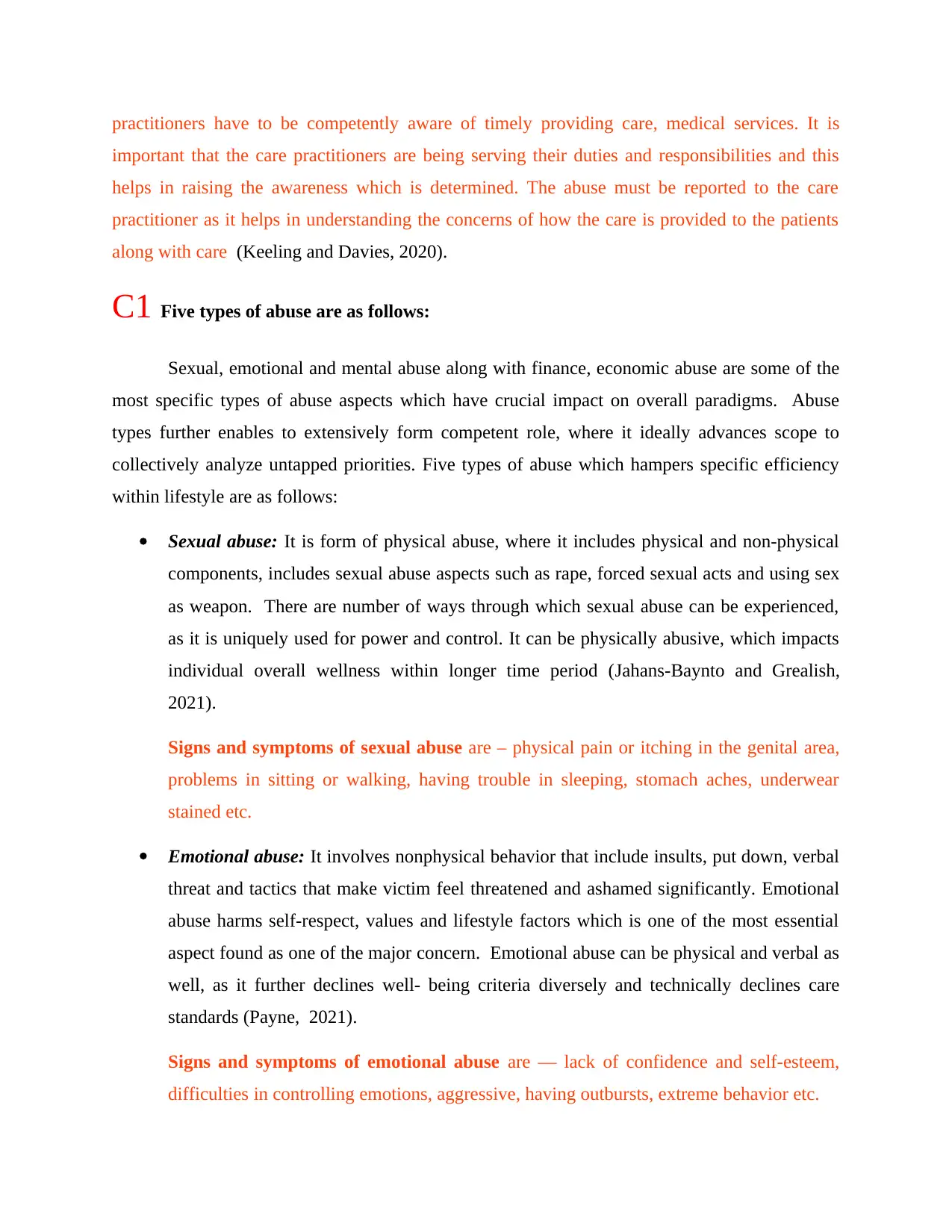
practitioners have to be competently aware of timely providing care, medical services. It is
important that the care practitioners are being serving their duties and responsibilities and this
helps in raising the awareness which is determined. The abuse must be reported to the care
practitioner as it helps in understanding the concerns of how the care is provided to the patients
along with care (Keeling and Davies, 2020).
C1 Five types of abuse are as follows:
Sexual, emotional and mental abuse along with finance, economic abuse are some of the
most specific types of abuse aspects which have crucial impact on overall paradigms. Abuse
types further enables to extensively form competent role, where it ideally advances scope to
collectively analyze untapped priorities. Five types of abuse which hampers specific efficiency
within lifestyle are as follows:
Sexual abuse: It is form of physical abuse, where it includes physical and non-physical
components, includes sexual abuse aspects such as rape, forced sexual acts and using sex
as weapon. There are number of ways through which sexual abuse can be experienced,
as it is uniquely used for power and control. It can be physically abusive, which impacts
individual overall wellness within longer time period (Jahans‐Baynto and Grealish,
2021).
Signs and symptoms of sexual abuse are – physical pain or itching in the genital area,
problems in sitting or walking, having trouble in sleeping, stomach aches, underwear
stained etc.
Emotional abuse: It involves nonphysical behavior that include insults, put down, verbal
threat and tactics that make victim feel threatened and ashamed significantly. Emotional
abuse harms self-respect, values and lifestyle factors which is one of the most essential
aspect found as one of the major concern. Emotional abuse can be physical and verbal as
well, as it further declines well- being criteria diversely and technically declines care
standards (Payne, 2021).
Signs and symptoms of emotional abuse are — lack of confidence and self-esteem,
difficulties in controlling emotions, aggressive, having outbursts, extreme behavior etc.
important that the care practitioners are being serving their duties and responsibilities and this
helps in raising the awareness which is determined. The abuse must be reported to the care
practitioner as it helps in understanding the concerns of how the care is provided to the patients
along with care (Keeling and Davies, 2020).
C1 Five types of abuse are as follows:
Sexual, emotional and mental abuse along with finance, economic abuse are some of the
most specific types of abuse aspects which have crucial impact on overall paradigms. Abuse
types further enables to extensively form competent role, where it ideally advances scope to
collectively analyze untapped priorities. Five types of abuse which hampers specific efficiency
within lifestyle are as follows:
Sexual abuse: It is form of physical abuse, where it includes physical and non-physical
components, includes sexual abuse aspects such as rape, forced sexual acts and using sex
as weapon. There are number of ways through which sexual abuse can be experienced,
as it is uniquely used for power and control. It can be physically abusive, which impacts
individual overall wellness within longer time period (Jahans‐Baynto and Grealish,
2021).
Signs and symptoms of sexual abuse are – physical pain or itching in the genital area,
problems in sitting or walking, having trouble in sleeping, stomach aches, underwear
stained etc.
Emotional abuse: It involves nonphysical behavior that include insults, put down, verbal
threat and tactics that make victim feel threatened and ashamed significantly. Emotional
abuse harms self-respect, values and lifestyle factors which is one of the most essential
aspect found as one of the major concern. Emotional abuse can be physical and verbal as
well, as it further declines well- being criteria diversely and technically declines care
standards (Payne, 2021).
Signs and symptoms of emotional abuse are — lack of confidence and self-esteem,
difficulties in controlling emotions, aggressive, having outbursts, extreme behavior etc.
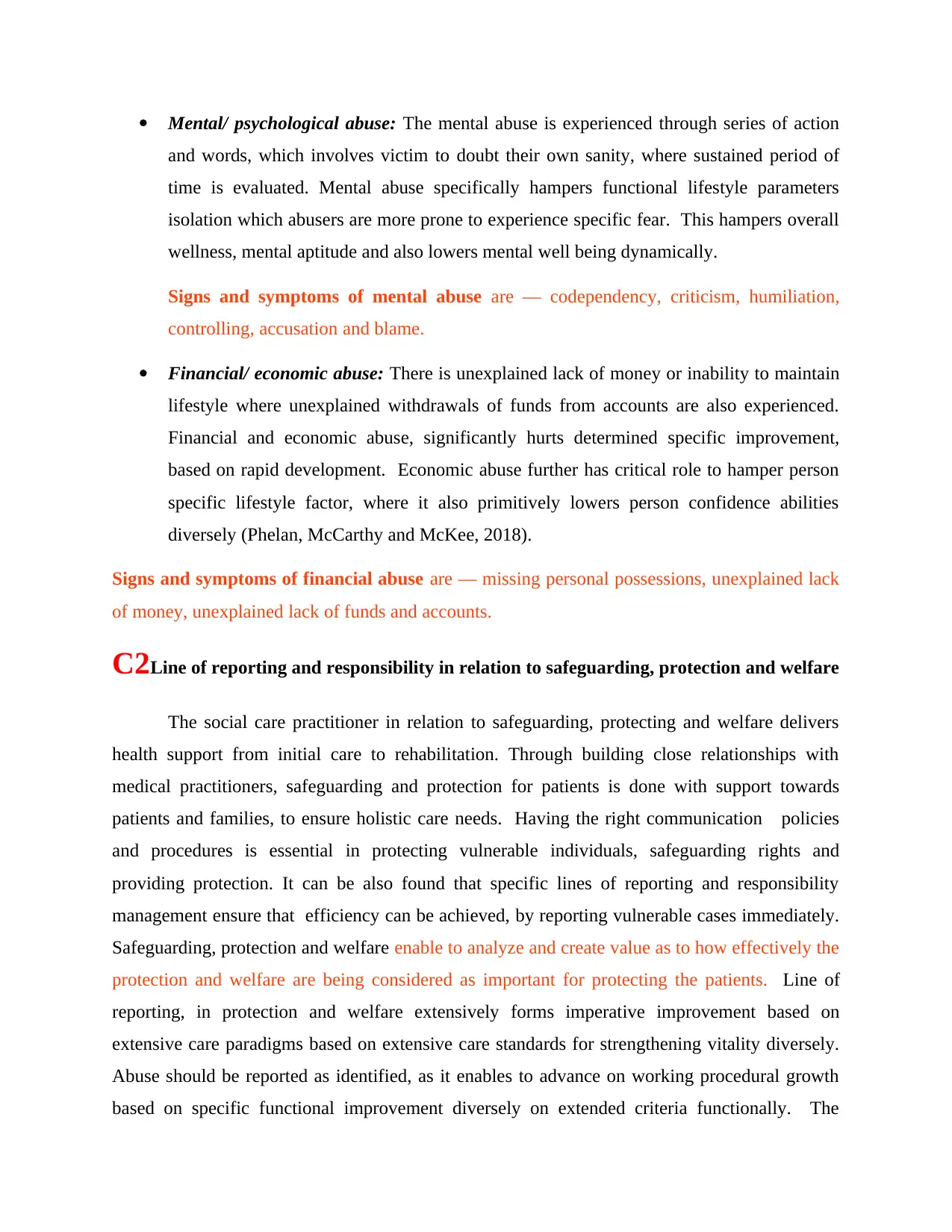
Mental/ psychological abuse: The mental abuse is experienced through series of action
and words, which involves victim to doubt their own sanity, where sustained period of
time is evaluated. Mental abuse specifically hampers functional lifestyle parameters
isolation which abusers are more prone to experience specific fear. This hampers overall
wellness, mental aptitude and also lowers mental well being dynamically.
Signs and symptoms of mental abuse are — codependency, criticism, humiliation,
controlling, accusation and blame.
Financial/ economic abuse: There is unexplained lack of money or inability to maintain
lifestyle where unexplained withdrawals of funds from accounts are also experienced.
Financial and economic abuse, significantly hurts determined specific improvement,
based on rapid development. Economic abuse further has critical role to hamper person
specific lifestyle factor, where it also primitively lowers person confidence abilities
diversely (Phelan, McCarthy and McKee, 2018).
Signs and symptoms of financial abuse are — missing personal possessions, unexplained lack
of money, unexplained lack of funds and accounts.
C2Line of reporting and responsibility in relation to safeguarding, protection and welfare
The social care practitioner in relation to safeguarding, protecting and welfare delivers
health support from initial care to rehabilitation. Through building close relationships with
medical practitioners, safeguarding and protection for patients is done with support towards
patients and families, to ensure holistic care needs. Having the right communication policies
and procedures is essential in protecting vulnerable individuals, safeguarding rights and
providing protection. It can be also found that specific lines of reporting and responsibility
management ensure that efficiency can be achieved, by reporting vulnerable cases immediately.
Safeguarding, protection and welfare enable to analyze and create value as to how effectively the
protection and welfare are being considered as important for protecting the patients. Line of
reporting, in protection and welfare extensively forms imperative improvement based on
extensive care paradigms based on extensive care standards for strengthening vitality diversely.
Abuse should be reported as identified, as it enables to advance on working procedural growth
based on specific functional improvement diversely on extended criteria functionally. The
and words, which involves victim to doubt their own sanity, where sustained period of
time is evaluated. Mental abuse specifically hampers functional lifestyle parameters
isolation which abusers are more prone to experience specific fear. This hampers overall
wellness, mental aptitude and also lowers mental well being dynamically.
Signs and symptoms of mental abuse are — codependency, criticism, humiliation,
controlling, accusation and blame.
Financial/ economic abuse: There is unexplained lack of money or inability to maintain
lifestyle where unexplained withdrawals of funds from accounts are also experienced.
Financial and economic abuse, significantly hurts determined specific improvement,
based on rapid development. Economic abuse further has critical role to hamper person
specific lifestyle factor, where it also primitively lowers person confidence abilities
diversely (Phelan, McCarthy and McKee, 2018).
Signs and symptoms of financial abuse are — missing personal possessions, unexplained lack
of money, unexplained lack of funds and accounts.
C2Line of reporting and responsibility in relation to safeguarding, protection and welfare
The social care practitioner in relation to safeguarding, protecting and welfare delivers
health support from initial care to rehabilitation. Through building close relationships with
medical practitioners, safeguarding and protection for patients is done with support towards
patients and families, to ensure holistic care needs. Having the right communication policies
and procedures is essential in protecting vulnerable individuals, safeguarding rights and
providing protection. It can be also found that specific lines of reporting and responsibility
management ensure that efficiency can be achieved, by reporting vulnerable cases immediately.
Safeguarding, protection and welfare enable to analyze and create value as to how effectively the
protection and welfare are being considered as important for protecting the patients. Line of
reporting, in protection and welfare extensively forms imperative improvement based on
extensive care paradigms based on extensive care standards for strengthening vitality diversely.
Abuse should be reported as identified, as it enables to advance on working procedural growth
based on specific functional improvement diversely on extended criteria functionally. The
⊘ This is a preview!⊘
Do you want full access?
Subscribe today to unlock all pages.

Trusted by 1+ million students worldwide
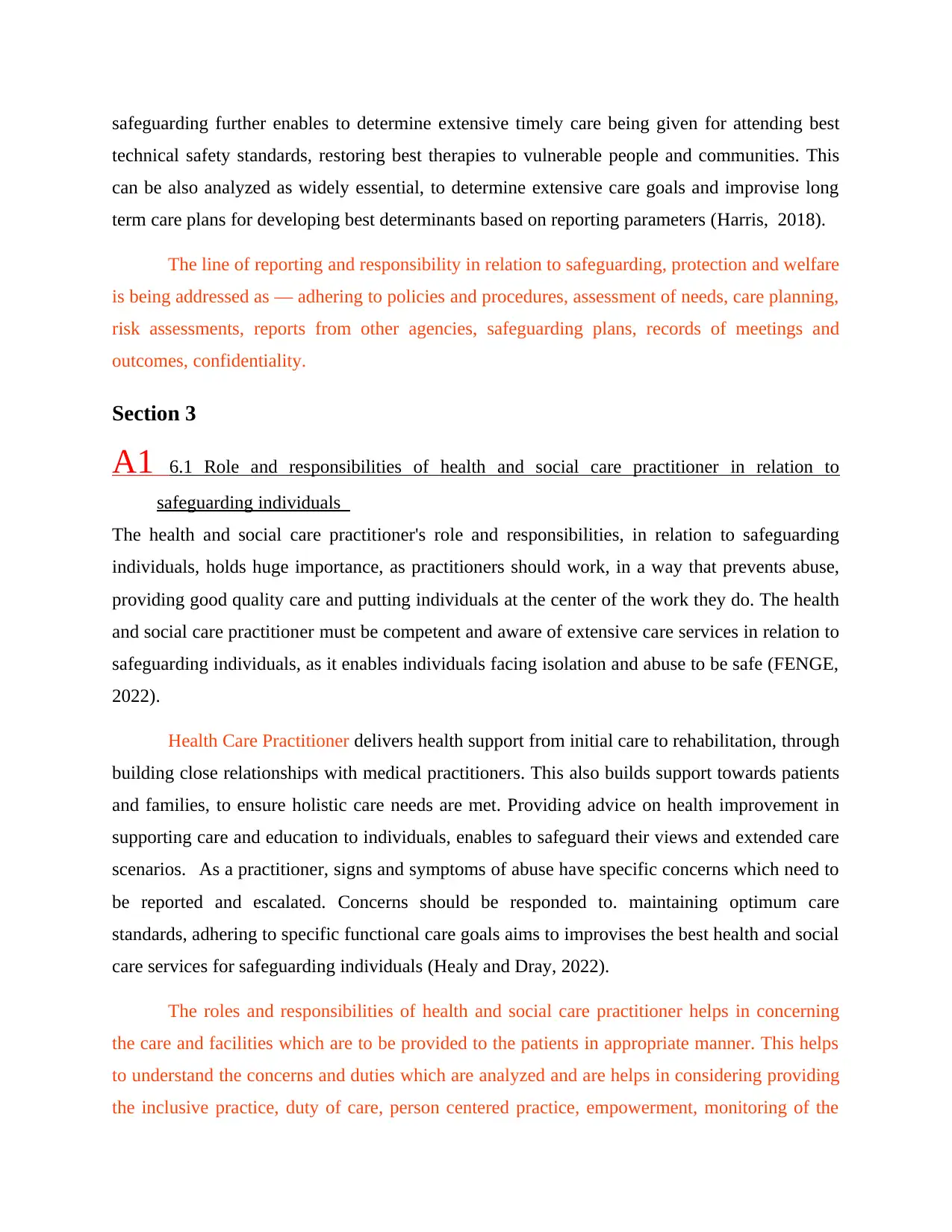
safeguarding further enables to determine extensive timely care being given for attending best
technical safety standards, restoring best therapies to vulnerable people and communities. This
can be also analyzed as widely essential, to determine extensive care goals and improvise long
term care plans for developing best determinants based on reporting parameters (Harris, 2018).
The line of reporting and responsibility in relation to safeguarding, protection and welfare
is being addressed as — adhering to policies and procedures, assessment of needs, care planning,
risk assessments, reports from other agencies, safeguarding plans, records of meetings and
outcomes, confidentiality.
Section 3
A1 6.1 Role and responsibilities of health and social care practitioner in relation to
safeguarding individuals
The health and social care practitioner's role and responsibilities, in relation to safeguarding
individuals, holds huge importance, as practitioners should work, in a way that prevents abuse,
providing good quality care and putting individuals at the center of the work they do. The health
and social care practitioner must be competent and aware of extensive care services in relation to
safeguarding individuals, as it enables individuals facing isolation and abuse to be safe (FENGE,
2022).
Health Care Practitioner delivers health support from initial care to rehabilitation, through
building close relationships with medical practitioners. This also builds support towards patients
and families, to ensure holistic care needs are met. Providing advice on health improvement in
supporting care and education to individuals, enables to safeguard their views and extended care
scenarios. As a practitioner, signs and symptoms of abuse have specific concerns which need to
be reported and escalated. Concerns should be responded to. maintaining optimum care
standards, adhering to specific functional care goals aims to improvises the best health and social
care services for safeguarding individuals (Healy and Dray, 2022).
The roles and responsibilities of health and social care practitioner helps in concerning
the care and facilities which are to be provided to the patients in appropriate manner. This helps
to understand the concerns and duties which are analyzed and are helps in considering providing
the inclusive practice, duty of care, person centered practice, empowerment, monitoring of the
technical safety standards, restoring best therapies to vulnerable people and communities. This
can be also analyzed as widely essential, to determine extensive care goals and improvise long
term care plans for developing best determinants based on reporting parameters (Harris, 2018).
The line of reporting and responsibility in relation to safeguarding, protection and welfare
is being addressed as — adhering to policies and procedures, assessment of needs, care planning,
risk assessments, reports from other agencies, safeguarding plans, records of meetings and
outcomes, confidentiality.
Section 3
A1 6.1 Role and responsibilities of health and social care practitioner in relation to
safeguarding individuals
The health and social care practitioner's role and responsibilities, in relation to safeguarding
individuals, holds huge importance, as practitioners should work, in a way that prevents abuse,
providing good quality care and putting individuals at the center of the work they do. The health
and social care practitioner must be competent and aware of extensive care services in relation to
safeguarding individuals, as it enables individuals facing isolation and abuse to be safe (FENGE,
2022).
Health Care Practitioner delivers health support from initial care to rehabilitation, through
building close relationships with medical practitioners. This also builds support towards patients
and families, to ensure holistic care needs are met. Providing advice on health improvement in
supporting care and education to individuals, enables to safeguard their views and extended care
scenarios. As a practitioner, signs and symptoms of abuse have specific concerns which need to
be reported and escalated. Concerns should be responded to. maintaining optimum care
standards, adhering to specific functional care goals aims to improvises the best health and social
care services for safeguarding individuals (Healy and Dray, 2022).
The roles and responsibilities of health and social care practitioner helps in concerning
the care and facilities which are to be provided to the patients in appropriate manner. This helps
to understand the concerns and duties which are analyzed and are helps in considering providing
the inclusive practice, duty of care, person centered practice, empowerment, monitoring of the
Paraphrase This Document
Need a fresh take? Get an instant paraphrase of this document with our AI Paraphraser
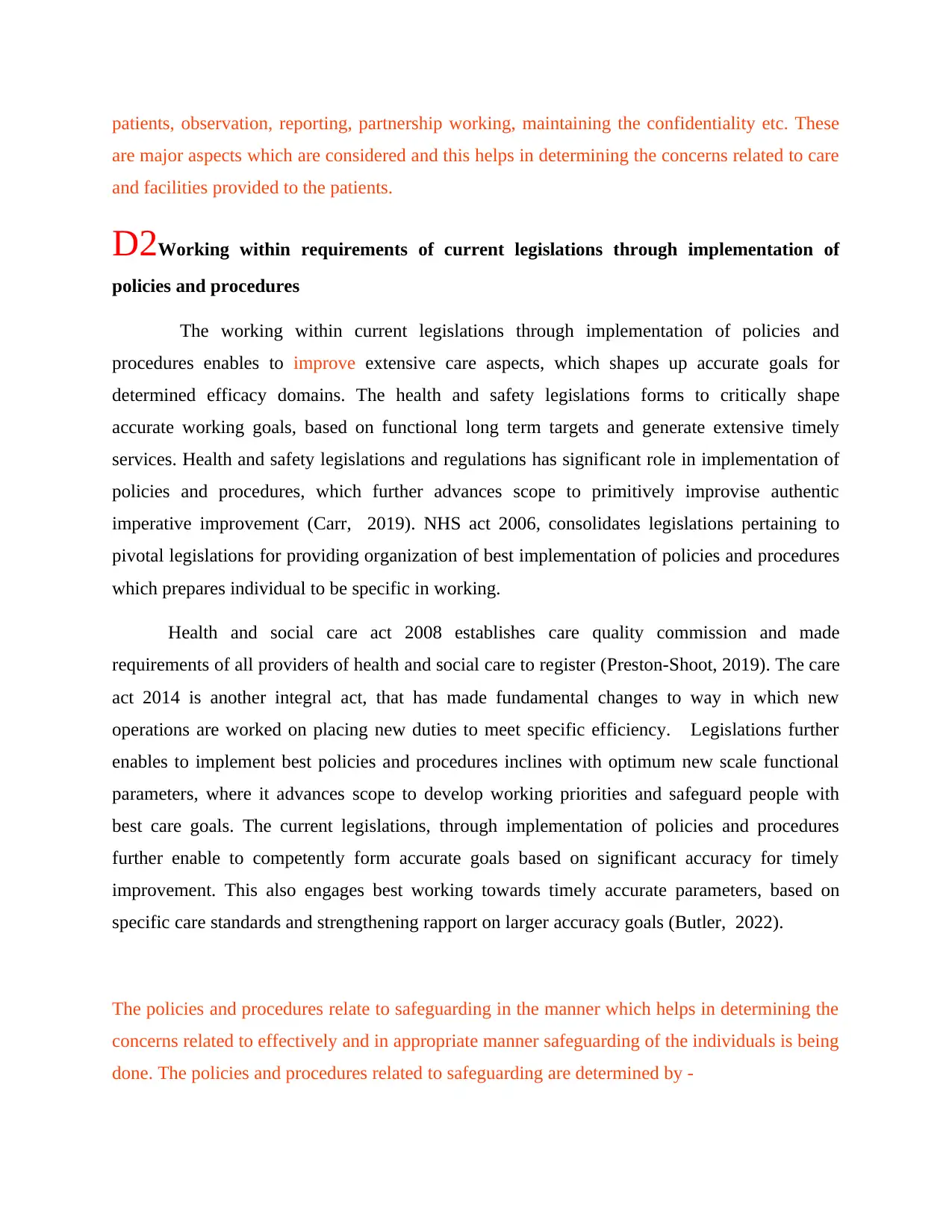
patients, observation, reporting, partnership working, maintaining the confidentiality etc. These
are major aspects which are considered and this helps in determining the concerns related to care
and facilities provided to the patients.
D2Working within requirements of current legislations through implementation of
policies and procedures
The working within current legislations through implementation of policies and
procedures enables to improve extensive care aspects, which shapes up accurate goals for
determined efficacy domains. The health and safety legislations forms to critically shape
accurate working goals, based on functional long term targets and generate extensive timely
services. Health and safety legislations and regulations has significant role in implementation of
policies and procedures, which further advances scope to primitively improvise authentic
imperative improvement (Carr, 2019). NHS act 2006, consolidates legislations pertaining to
pivotal legislations for providing organization of best implementation of policies and procedures
which prepares individual to be specific in working.
Health and social care act 2008 establishes care quality commission and made
requirements of all providers of health and social care to register (Preston-Shoot, 2019). The care
act 2014 is another integral act, that has made fundamental changes to way in which new
operations are worked on placing new duties to meet specific efficiency. Legislations further
enables to implement best policies and procedures inclines with optimum new scale functional
parameters, where it advances scope to develop working priorities and safeguard people with
best care goals. The current legislations, through implementation of policies and procedures
further enable to competently form accurate goals based on significant accuracy for timely
improvement. This also engages best working towards timely accurate parameters, based on
specific care standards and strengthening rapport on larger accuracy goals (Butler, 2022).
The policies and procedures relate to safeguarding in the manner which helps in determining the
concerns related to effectively and in appropriate manner safeguarding of the individuals is being
done. The policies and procedures related to safeguarding are determined by -
are major aspects which are considered and this helps in determining the concerns related to care
and facilities provided to the patients.
D2Working within requirements of current legislations through implementation of
policies and procedures
The working within current legislations through implementation of policies and
procedures enables to improve extensive care aspects, which shapes up accurate goals for
determined efficacy domains. The health and safety legislations forms to critically shape
accurate working goals, based on functional long term targets and generate extensive timely
services. Health and safety legislations and regulations has significant role in implementation of
policies and procedures, which further advances scope to primitively improvise authentic
imperative improvement (Carr, 2019). NHS act 2006, consolidates legislations pertaining to
pivotal legislations for providing organization of best implementation of policies and procedures
which prepares individual to be specific in working.
Health and social care act 2008 establishes care quality commission and made
requirements of all providers of health and social care to register (Preston-Shoot, 2019). The care
act 2014 is another integral act, that has made fundamental changes to way in which new
operations are worked on placing new duties to meet specific efficiency. Legislations further
enables to implement best policies and procedures inclines with optimum new scale functional
parameters, where it advances scope to develop working priorities and safeguard people with
best care goals. The current legislations, through implementation of policies and procedures
further enable to competently form accurate goals based on significant accuracy for timely
improvement. This also engages best working towards timely accurate parameters, based on
specific care standards and strengthening rapport on larger accuracy goals (Butler, 2022).
The policies and procedures relate to safeguarding in the manner which helps in determining the
concerns related to effectively and in appropriate manner safeguarding of the individuals is being
done. The policies and procedures related to safeguarding are determined by -
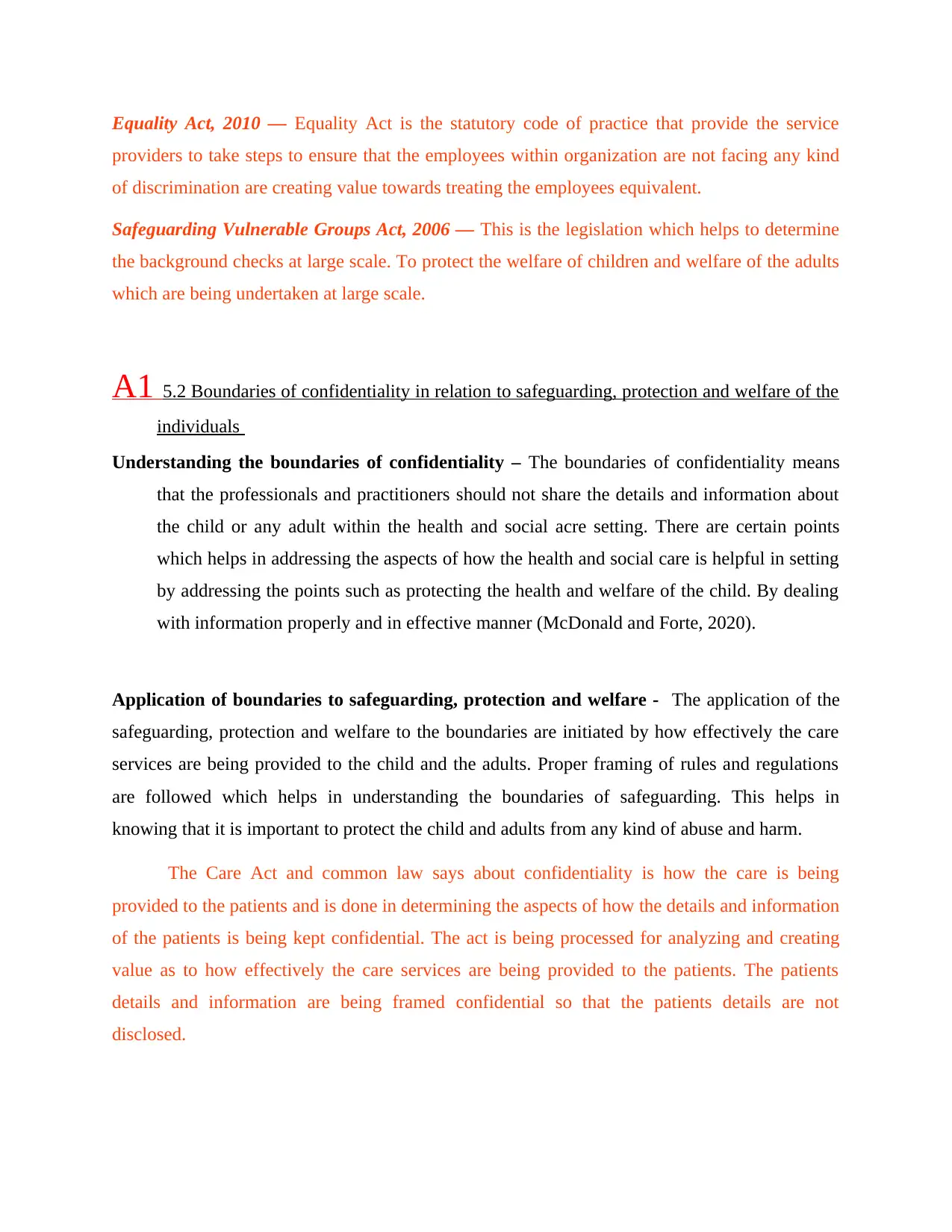
Equality Act, 2010 — Equality Act is the statutory code of practice that provide the service
providers to take steps to ensure that the employees within organization are not facing any kind
of discrimination are creating value towards treating the employees equivalent.
Safeguarding Vulnerable Groups Act, 2006 — This is the legislation which helps to determine
the background checks at large scale. To protect the welfare of children and welfare of the adults
which are being undertaken at large scale.
A1 5.2 Boundaries of confidentiality in relation to safeguarding, protection and welfare of the
individuals
Understanding the boundaries of confidentiality – The boundaries of confidentiality means
that the professionals and practitioners should not share the details and information about
the child or any adult within the health and social acre setting. There are certain points
which helps in addressing the aspects of how the health and social care is helpful in setting
by addressing the points such as protecting the health and welfare of the child. By dealing
with information properly and in effective manner (McDonald and Forte, 2020).
Application of boundaries to safeguarding, protection and welfare - The application of the
safeguarding, protection and welfare to the boundaries are initiated by how effectively the care
services are being provided to the child and the adults. Proper framing of rules and regulations
are followed which helps in understanding the boundaries of safeguarding. This helps in
knowing that it is important to protect the child and adults from any kind of abuse and harm.
The Care Act and common law says about confidentiality is how the care is being
provided to the patients and is done in determining the aspects of how the details and information
of the patients is being kept confidential. The act is being processed for analyzing and creating
value as to how effectively the care services are being provided to the patients. The patients
details and information are being framed confidential so that the patients details are not
disclosed.
providers to take steps to ensure that the employees within organization are not facing any kind
of discrimination are creating value towards treating the employees equivalent.
Safeguarding Vulnerable Groups Act, 2006 — This is the legislation which helps to determine
the background checks at large scale. To protect the welfare of children and welfare of the adults
which are being undertaken at large scale.
A1 5.2 Boundaries of confidentiality in relation to safeguarding, protection and welfare of the
individuals
Understanding the boundaries of confidentiality – The boundaries of confidentiality means
that the professionals and practitioners should not share the details and information about
the child or any adult within the health and social acre setting. There are certain points
which helps in addressing the aspects of how the health and social care is helpful in setting
by addressing the points such as protecting the health and welfare of the child. By dealing
with information properly and in effective manner (McDonald and Forte, 2020).
Application of boundaries to safeguarding, protection and welfare - The application of the
safeguarding, protection and welfare to the boundaries are initiated by how effectively the care
services are being provided to the child and the adults. Proper framing of rules and regulations
are followed which helps in understanding the boundaries of safeguarding. This helps in
knowing that it is important to protect the child and adults from any kind of abuse and harm.
The Care Act and common law says about confidentiality is how the care is being
provided to the patients and is done in determining the aspects of how the details and information
of the patients is being kept confidential. The act is being processed for analyzing and creating
value as to how effectively the care services are being provided to the patients. The patients
details and information are being framed confidential so that the patients details are not
disclosed.
⊘ This is a preview!⊘
Do you want full access?
Subscribe today to unlock all pages.

Trusted by 1+ million students worldwide
1 out of 17
Related Documents
Your All-in-One AI-Powered Toolkit for Academic Success.
+13062052269
info@desklib.com
Available 24*7 on WhatsApp / Email
![[object Object]](/_next/static/media/star-bottom.7253800d.svg)
Unlock your academic potential
Copyright © 2020–2025 A2Z Services. All Rights Reserved. Developed and managed by ZUCOL.




